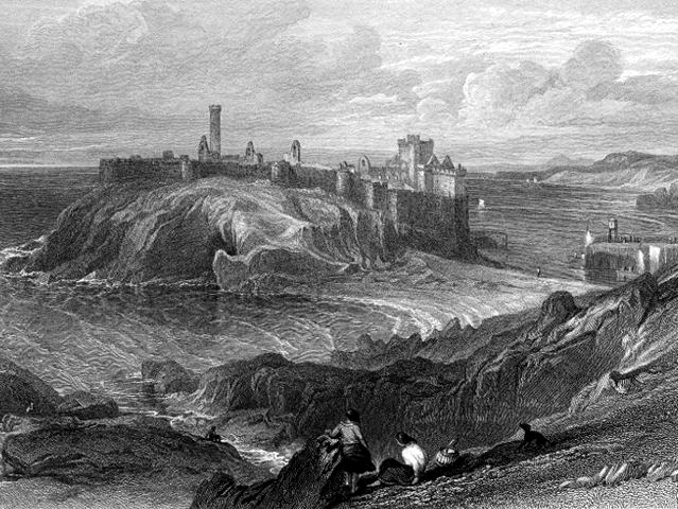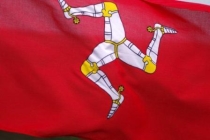Shakespeare, The Ghost of Eleanor Duchess of Gloucester and a Magnificent Haunted Manx Castle

Recently celebrations have taken place to mark 400 years after the death of Shakespeare on May 3, 1616. In Shakespeare’s play Henry VI.part 2 act 2.scene 3 reference is made to the imprisonment in the Manx fortress of Peel Castle (Manx: Cashtal Purt ny h-Inshey ) of Eleanor Cobham, Duchess of Gloucester (c.1400 – 7 July 1452):
Stand forth, Dame Eleanor Cobham, Gloucester's wife:
In sight of God and us, your guilt is great:
Receive the sentence of the law for sins
Such as by God's book are adjudged to death.
You four, from hence to prison back again;
From thence unto the place of execution:
The witch in Smithfield shall be burn'd to ashes,
And you three shall be strangled on the gallows.
You, madam, for you are more nobly born,
Despoiled of your honour in your life,
Shall, after three days' open penance done,
Live in your country here in banishment,
With Sir John Stanley, in the Isle of Man.
William Shakespeare, Henry VI, Part 2, Act 2, Scene 3.
Eleanor Cobham was the second wife of Humphrey Duke of Gloucester who held a powerful position at that time. He was the youngest son of Henry IV of England and his first wife Mary de Bohun. He was the brother of Henry V, and the uncle of Henry VI. Upon the death of his brother in 1422, Humphrey became Lord Protector to his young nephew King Henry VI. He also claimed the right to the regency of England following the death of his elder brother, John Duke of Bedford.

In 1441 Eleanor Cobham was tried and convicted of practising witchcraft against the King in an attempt to retain power for her husband. In October 1440 Roger Bolingbroke one of the Duke’s household and a noted astrologer and Thomas Southwell produced a horoscope for Eleanor Cobham which predicted the death of King Henry, which would have resulted in the Duke of Gloucester becoming King and Eleanor his Queen. On hearing of this prediction, The Kings Council charged Bolingbroke and Southwell, and John Home (Eleanor's personal confessor) with conspiring to kill the King with necromancy, which is a form of magic involving communication with the dead. Under questioning Bolingbroke named Eleanor as the instigator. Also named in the conspiracy to harm the King was Margery Jourdemayne, "the Witch of Eye Next Westminster" (c.1415 – 27 October 1441). One of the charges against her was that she had made a waxen image of the king, which when melted away resulted in a decline in the King's health.
Margery Jourdemayne was said to have a reputation as someone who could provide potions and spells that could be used to instigate love and help in encouraging pregnancy or in the termination of an unwanted child. It was in seeking to become pregnant that Eleanor Cobham said at her trial that she had sought the help of Margery. She also appears in William Shakespeare’s Henry VI, Part 2 as Margery Jourdayn, along with her co-accused. She met a terrible end and was burnt at stake as a witch. Thomas Southwell died in the Tower of London and Roger Bolingbroke was hanged drawn and quartered. As for Eleanor Duchess of Gloucester she was forced to undertake public penance and walk through the city of London without a hood, and bearing a lighted taper. Life imprisonment in various remote locations followed. In July 1446 she was sent to Peel Castle (Manx: Cashtal Purt ny h-Inshey) on the Isle of Man (Mannin) in the north of the Irish Sea. She remained there until March 1449 when she was moved to Beaumaris Castle in Anglesey (Welsh: Ynys Môn) an island of the north-west coast of Wales where she died on 7 July 1452.
It is to Peel Castle though that it is said her restless spirit returns. The attractive and quite well preserved historical Castle stands on Patrick’s Isle (Manx: Ellan Noo Perick), a small island off the west coast of the Isle of Man. It is a place with strange magical quality where archeological studies have revealed permanent occupation on St Patrick's Isle dating to the Late Bronze Age. It is to the Isle where some say St Patrick first set foot in the Isle of Man in 444 AD while returning from England to Ireland. He is then said to have appointed the Celtic missionary St German who lived from approximately 410 AD to 474 AD and oversaw further development of the Church on the Isle of Man. On the site of the Castle the remains of buildings belonging to the Celtic monastery, possibly dating from the 6-8th centuries can be seen. Dominating these remains stands the Irish style round tower; early medieval stone towers of a type found mainly in Ireland, but there are two in Scotland and this one on St Patrick’s Isle on the Isle of Man.

The first known fortification on St Patrick’s Isle came after the arrival in 1098 of the Viking chieftain Magnus Olafsson (Old Norse: Magnús Óláfsson), better known as Magnus Barefoot who was King Magnus III of Norway from 1093 until his death in 1103. Magnus campaigned around the Irish Sea from 1098 to 1099. The medieval Chronicles of the Kings of Mann and the Isles tell us that he saw to the erection of two wooden prefabricated forts, one now believed to be in the South of the Isle of Man and the other on St Patrick’s Isle. Other buildings still visible on the Isle are the 13th century cathedral of St German and later buildings allied to it, as well as medieval armory and barracks. These are protected by fortifications consisting of 14th century flanking towers, linked by 15th century curtain walls. More recent military construction took place in the early 19th century during the Napoleonic wars and later in the 1860s during the time of Napoleon III.
Set on St Patrick’s Isle Peel Castle is a magnificent fortress. It is place of great beauty especially when framed by still blue waters and sky on a clear, calm day. However, the mood of the Irish Sea can change quickly. When the skies grow black and the sea is whipped into a frenzy the castle looks dark and foreboding. The angry waves crash against the rocks of the Isle and smash against the castle walls as if insulted by this human creation imposing itself in nature’s domain. It must have been a dreadful place to be imprisoned and Eleanor Duchess of Gloucester has been described as turbulent and impatient when under confinement there. Guards kept a strict watch guard over her; not only to prevent attempts to facilitate her escape, but also it is said to stop her from taking her own life. Perhaps then it is no surprise then that her spirit is thought to roam the site of her unhappy confinement. Traditionally it is told that her footsteps can be heard to go up the stone stairs from her dungeon deep below the castle walls.

Eleanor Duchess of Gloucester is not the only ghost that haunts Peel Castle. Amongst its supernatural residents is the famous Moddey Doo (Black Dog). It is told that anyone who encounters this demon dog will meet a bad end. Perhaps Eleanor met the Moddey Doo during her imprisonment in the castle. We will never know, but if you visit the town of Peel (Manx: Purt ny h-Inshey) on the beautiful Isle of Man (Mannin) make sure you go to the magnificent Peel Castle. Although it is wise to leave before the sun sinks below the hills of Ireland that lie to the west. You never know who or what you might bump into on a dark night in Cashtal Purt ny h-Inshey. To return again to William Shakespeare and quote from his play Hamlet “There are more things in heaven and earth, Horatio, than are dreamt of in your philosophy.”
In acknowledgment to Mrs Margaret Brady of Yn Cheshaght Vanninagh Lunnin (London Manx Society), who provided the information that inspired this article.
- Manx
- English
- Log in to post comments






